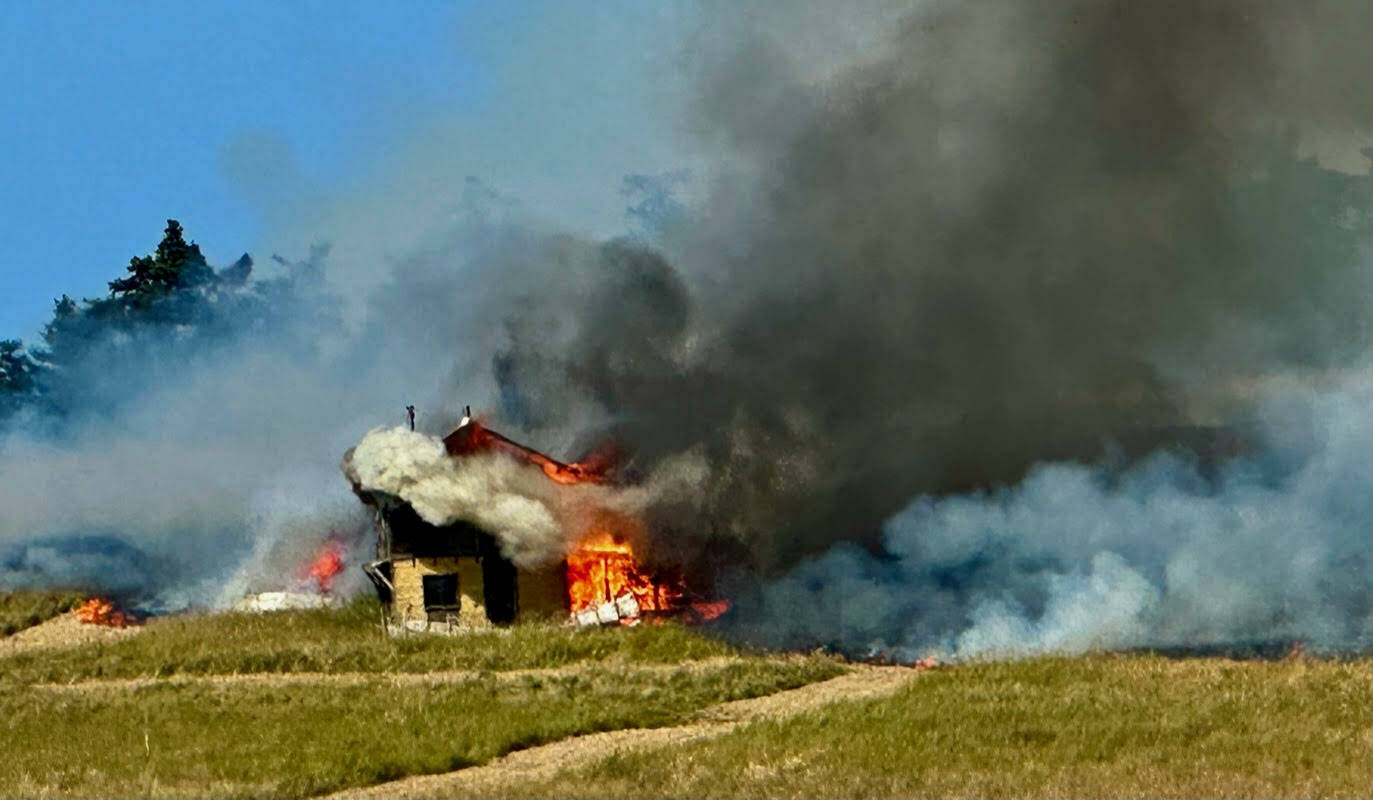A July 5th fire on Protection Island was spotted by residents on the mainland who contacted 911 as well as Marty Bluewater, the island’s last human resident. He said that 911 was “inundated” with calls.
The fire was extinguished in about two hours, with the toll the loss of a structure — one that was slated for demolition — along with approximately 15 acres of non-native invasive annual pasture grasses within an area Bluewater said was being mowed for a controlled burn to be replaced with native grasses and other meadow plants.
Sparks from the burning structure could possibly have spread the fire further, Bluewater said.
“Fortunately it wasn’t as windy as it could be or it would’ve added to the problem,” he said.
The state Department of Natural Resources provided firefighters and a helicopter to deliver firefighters and drop water, Olympic National Park Wildland Fire Module provided incident command, and firefighters with the National Park Service, U.S. Forest Service and U.S. Fish and Wildlife Service (FWS), and U.S. Fish and Wildlife Service refuge staff responded to the incident, according to FWS communications officer Megan Nagal.
Bluewater said that if there was firefighting equipment on the island, the fire could have been out very quickly. He said he hopes that suitable equipment will be permanently lodged on the island, which is very dry and has only a few water seeps on the northern beach.
“I’m so thankful for the response of the helicopter people and the other firefighters who showed up,” Bluewater said.
“They’re the ones who saved the day and prevented a much bigger disaster.”
Background
This is the second fire in two years on the 379-acre island, a national wildlife wildlife sanctuary controlled primarily by the federal government. About 47.5 acres is owned by Washington state and is known as the Zella M. Schultz Seabird Sanctuary.
It was there, on Kanem Spit, that an Aug. 3, 2021 fire consumed about 26 acres of seal, shorebird and seabird habitat before being subdued by the efforts of crews from multiple state and federal agencies.
Scott Pearson, a Washington Department of Fish and Wildlife senior research scientist, wrote in September of that year: “The extremely dry grasses that dominate much of the island in late summer are very combustible, and, as a result, fire spreads easily. We were fortunate that the wind was in the direction that it was! If the wind was in the other direction, there is a good chance that all or much of the island would have been affected and even more birds would have been killed.”
Dubbed by Captain George Vancouver in 1792, Protection Island’s name has taken on depths of meaning since it was declared the Protection Island National Wildlife Refuge in 1982.
It is recognized, wrote Pearson, as “the most important seabird nesting site in the Salish Sea both in terms of absolute numbers and the diversity of species nesting on the Island.”
Tufted Puffins, Rhinoceros Auklets, Glaucous-winged Gulls, Pigeon Guillemots, Pelagic Cormorants and Black Oystercatchers (a shorebird) all nest on the island, he noted.
Pearson said that it has historically supported the largest Glaucous-winged Gull colony in the Salish Sea and the largest Rhinoceros Auklet Colony in Washington state – the 10th-largest in the world. He said that in 2008 scientists estimated there were 54,797 burrows, with 36,145 estimated to be occupied — about 72,000 birds, assuming a male and female pair per burrow.
The island also hosts about half of the remaining breeding pairs of Tufted Puffins in the Puget Sound, around five or six.
“A lot of people don’t realize how fragile things are,” Bluewater said. “It’s always going to be an issue that we’ve got to keep an eye on and educate people about.”
He has battled other fires since he bought his piece of land in 1971, back when the island was being marketed as a vacation getaway, most notably a beach fire “started by a couple of kids” that he battled for five or six hours one night, and an interior fire started by fireworks.
“We had a little fire truck then, but it was private,” Bluewater said.
Now in his early 70s, Bluewater said that he is contemplating writing a book about the island, illustrated with some of the thousands of photographs he’s taken there over the years. There are many stories involved with the island, he said.
“A lot of heartbreaking stories.”
Bluewater, like the watchers on the mainland who alerted authorities, doesn’t want an out-of-control fire to be one of those stories.
Peninsula Daily News reporter Peter Segall contributed to this report.



